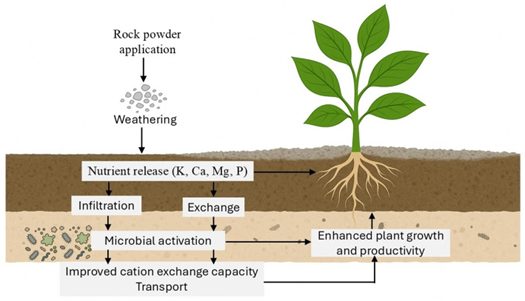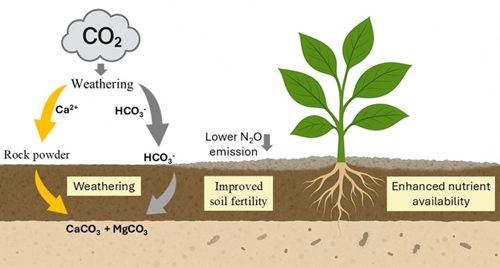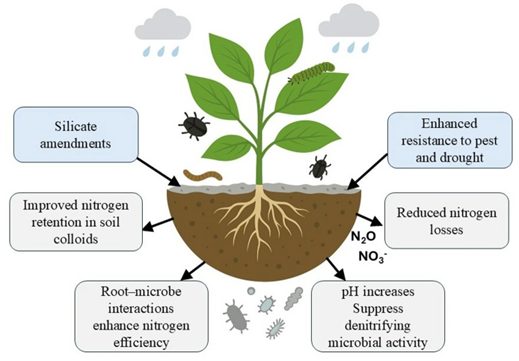From Mine to Field: A Circular Economy Approach
Soils around the world are losing their strength. Years of industrial farming have removed important minerals and organic matter, leaving weak ecosystems that need more and more fertilizer to maintain production. At the same time, mining and construction activities create billions of tons of fine rock byproducts every year. Much of this byproduct, rich in silicate minerals, is stored in tailings ponds or piles that damage landscapes and pose long-term environmental risks.

In a recent 2025 paper published by Palma et al. in Environmental Systems Research, titled “Valorization of Mineral By-Products through Soil Remineralization Enhances Sustainable Agriculture and Circular Economy Outcomes”, researchers argue that these two global problems could in fact solve each other. The study explains that when finely ground rock dust is added to farmland (a process known as soil remineralization), waste can turn into a valuable resource. The minerals released from rock dust can restore soil fertility and capture carbon from the atmosphere, connecting agriculture, climate action, and resource recovery in one process.
The study places soil remineralization within the wider idea of a circular economy. They argue that rock byproducts should not be treated as waste but as potential inputs for farming systems. These finely milled silicate rocks contain key nutrients such as potassium, calcium, and magnesium that plants need for healthy growth. When these materials are left to accumulate in dumps or tailings dams, they represent a lost opportunity. But if they are reintroduced into agricultural systems, they can close the resource loop. The authors call this process part of a circular value chain, where materials move from mining waste streams back into productive use.

The science behind soil remineralization lies in a simple but powerful natural process: rock weathering. This is the gradual breakdown of minerals that releases nutrients and reacts with carbon dioxide to form stable compounds. When this process is accelerated by applying fine silicate rock powders, it brings several benefits to both soil and climate. The dust adds back lost nutrients, which increases fertility and reduces dependence on chemical fertilizers. It also removes carbon dioxide from the air, because silicate minerals react with CO₂ and form carbonates that stay locked in the soil for a long time. In addition, the extra mineral particles improve soil structure by helping it hold water and air, which makes it easier for roots to grow and for microbes to thrive. Since remineralization works slowly, it supports gradual but lasting soil recovery instead of short bursts of productivity.
This combination of processes links soil chemistry with carbon capture and resource reuse. It also works especially well in tropical and subtropical regions, such as large parts of Brazil, where soils are deeply weathered and nutrient-poor. These areas have lost much of their potassium, calcium, and magnesium due to heavy rainfall and leaching. However, they also host many mining industries that produce mineral-rich rock dust. These byproducts match the chemical needs of degraded soils, so applying them can both restore nutrients and increase long-term carbon storage in the ground.
A Brazilian Case
The study points to Brazil as a global leader in implementing remineralization policy. The country’s vast agricultural frontier and mineral-rich geology create ideal conditions for such integration. Under the Brazilian Emissions Trading System (SBCE), remineralizers are officially recognized as a new category of agricultural input.

This policy change allows mining byproducts to be processed, certified, and sold as soil amendments, creating an industrial link between mining and farming. As a result, Brazil is reducing the amount of waste sent to tailings dams and landfills, while also lowering its dependence on imported fertilizers. This approach helps local industries grow, supports rural economies, and improves the national carbon balance by combining agricultural productivity with carbon capture.
Traditional models of industrial production follow a linear path: extract, use, discard. The valorization approach in remineralization transforms this path into a loop by reintroducing rock dust into new cycles of use.
The framework proposed by the study outlines several key stages. First, mineral byproducts are identified and tested to understand their composition. Then they are ground to suitable particle sizes and certified as safe for agricultural use. After that, they are distributed through local supply networks and applied to farmland. Finally, researchers and farmers monitor the results by analyzing soils and crops.
Together, these stages create a circular system that links industry, agriculture, and policy. Mining companies reduce their waste footprint, farmers gain affordable and sustainable soil inputs, and governments advance climate goals while creating a circular economy.
Challenges
Despite its promise, the paper notes that scaling up soil remineralization is complex. Not all mineral byproducts are suitable for this purpose, because their chemical composition and mineral structure can vary. Some tailings contain trace metals such as chromium or nickel, which must be avoided through careful testing and monitoring.

Another challenge is energy use. Grinding rock into fine powder speeds up weathering but also consumes energy, which can reduce the carbon benefits if fossil fuels are used. One of the benefits of using mining byproducts, however, is that the rocks are often already ground to the appropriate particle size, or at least close to it.
Transportation adds another layer of difficulty, since moving heavy rock dust across long distances raises costs and emissions. Therefore, local sourcing and regional application are crucial for efficiency.
Finally, the authors highlight gaps in international rules and public awareness. While Brazil and some countries in Europe have created certification systems, global standards remain limited. The study suggests that harmonized regulations and greater outreach could support responsible and wider adoption of remineralization practices.
The beauty of soil remineralization lies in its simplicity. It requires no high-tech revolution, only a shift in techniques toward mimicking natural processes. The future of sustainability may already lie beneath our feet, in the minerals ready to nourish the Earth once again.
Qi Zheng is an undergraduate student in Environmental Policy and Sustainable Development with Economics at the London School of Economics and Political Science. She is interested in climate policy, soil carbon sequestration, and sustainable land management, and is also exploring the intersections of environmental governance and economic development.
Support us on Patreon
Thank you for joining us today! Please become a member of RTE and support us on Patreon. Unlike many larger organizations, we work with a team of determined and passionate volunteers to get our message out. We aim to continue to increase the awareness of remineralization to initiate projects across the globe that remineralize soils, grow nutrient dense food, regenerate our forests’ and stabilize the climate – with your help! If you can, please support us on a monthly basis from just $2, rest assured that you are making a big impact every single month in support of our mission. Thank you!








Got something to say?